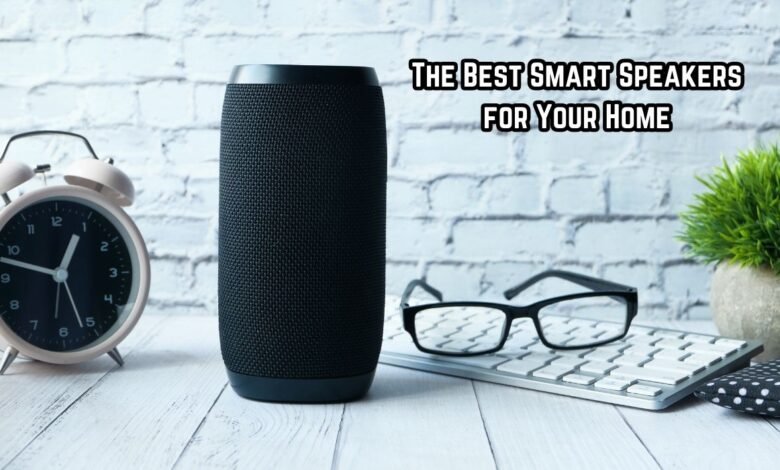The Best Smart Speakers for Your Home
Discover the best smart speakers for your home, offering top-notch audio quality, smart features, and seamless integration.

Smart speakers have become an important part of our homes. They are not just regular speakers, but they also have a virtual assistant with voice commands. This assistant can help you in many ways, such as playing songs, controlling smart home devices, setting reminders, telling the weather and also helping in online shopping.
How does a smart speaker work? It is powered by advanced AI devices and machine learning algorithms. Your voice is initially converted into waves by the speaker when you say something like “sing a song”. These waves then transform into digital data that computers can understand. Through internet, this data is sent to the cloud service. A cloud service help to understand the question and do the work. Because of this, using a smart speaker has become much easier these days!
Leading the way in the smart speaker industry are a number of well-known companies, each with unique characteristics offered to various consumer tastes. Amazon Echo by Alexa is well known for being highly integrated with a large number of smart home devices. Accurate search results and Good integration with Google’s ecosystem. Both are strengths of Google Assistant. Siri-equipped Apple HomePod prioritize privacy and excellent sound quality.
Smart speakers are easy to use by voice activation. They can also become main focus for smart home automation. Giving customers the power to manage security systems, lights, thermostats, and other appliances from a single device. This improves the user experience and it becomes much easier to manage multiple smart devices. Let’s check out some of best smart speaker for your home.
Best Smart Speakers for Your Home
New smart speakers with features that are easy to use:
Amazon Echo Dot (5th Generation)
Powered by Alexa, compact design, improved sound quality, 1.6-inch front-firing speaker.
| Pros | Cons |
|---|---|
| Affordable | Limited audio performance for larger spaces |
| Seamless integration with Amazon ecosystem | Lacks some advanced features compared to higher-end models |
| Excellent voice recognition | … |
Google Nest Audio
Google Assistant-enabled, 75mm woofer, 19mm tweeter, touch controls, fabric-covered design.
| Pros | Cons |
|---|---|
| Superior sound quality | Larger footprint |
| Robust Google Home integration | Limited |
Apple HomePod Mini
Siri-enabled, 360-degree sound, S5 chip, intercom functionality, seamless Apple ecosystem integration.
| Pros | Cons |
|---|---|
| Compact size | Limited to Apple ecosystem |
| Exceptional audio quality for its size | Higher price point than some competitors |
| Strong privacy features | … |
Sonos One (Gen 2)
Dual amplifiers, voice control with Alexa and Google Assistant, humidity resistant, compatible with Sonos app.
| Pros | Cons |
|---|---|
| Excellent sound quality | Higher price point |
| Versatile voice assistant options | Requires Sonos app for full functionality |
| Multi-room audio support | … |
Bose Home Speaker 500
Built-in Alexa and Google Assistant, 8-microphone array, color LCD display, Bose Music app compatibility.
| Pros | Cons |
|---|---|
| Premium sound quality | Expensive |
| Wide voice assistant support | Larger size may not suit all spaces |
| Sleek design | … |
Features of smart speakers is a perfect option for every home. Whether you are looking for robust sound quality, seamless integration into smart home ecosystem, or a budget-friendly choice. Each model offers unique features and good user experiences.
Here is how to Choose Right Smart Speaker for Your Home
For best smart speaker for your home keep in mind several key factors.
Sound Quality
Firstly look for sound quality. If you love music or use your speaker for music, podcasts, or other audio then it’s important to invest in a smart speaker with high-quality sound. Look for these features:
- Great sound quality
- Extra speakers or subwoofers for deep bass
- Sound that adjusts to the room
Compatibility with Smart Home Devices
Your smart speaker should easly integrate with your existing smart home ecosystem. Check compatibility with:
- Smart lights, thermostats, and security systems
- Popular smart home systems like Google Home, Amazon Alexa, or Apple HomeKit
- Other devices like smart TVs and appliances
Making sure everything works together and lets you control all your devices from one place, making life easier.
Price Range
Smart speakers has wide range of prices, from budget-friendly options to expensive. Decide your budget and compare features at different prices. Think about these factors:
- Basic models for basic voice commands and sound quality
- Mid-range options with better sound and more features
- Premium models with advanced capabilities and superior sound
Voice Assistant Preferences
Voice assistant can really affect how you use your device. Popular options include:
- Amazon Alexa: Lots of skills and works with many devices
- Google Assistant: Strong search and works well with Google services
- Apple Siri: Best for Apple users
Consider which voice assistant is best for your daily routines and existing devices.
Personal Preferences and Home Setup
Your choice should reflect your personal preferences and home setup. Think about these:
- The speaker’s size and design should match your home decor.
- Consider how you’ll use it—entertainment, smart home control, or both.
- Look for features you need, like multilingual support or privacy controls.
By considering these factors carefully, you can choose a smart speaker that improves your home and meets your needs.
Setting Up and Maximizing Your Smart Speaker
Setting up a smart speaker can change your daily routine with hands-free help, entertainment, and home automation. Follow these steps to set it up correctly and integrate it with your home.
Setting Up and Maximizing Smart Speaker
1. Unboxing and Initial Setup:
Put your smart speaker in a central spot in your home. Make sure it’s near a power outlet and within Wi-Fi range.
2. Connecting to Wi-Fi:
Plug in smart speaker and download its app on your phone or tablet. Open the app and follow instructions to connect speaker to your Wi-Fi.
3. Setting Up Voice Recognition:
Set up voice recognition to personalize responses. Follow app’s prompts to train speaker to recognize your voice and other household members.
4. Integrating with Other Smart Devices:
Use app to connect the smart speaker with other devices like lights, thermostats, and security systems for easy voice control.
Maximizing Your Smart Speaker
To get the most out of your smart speaker, consider these tips:
1. Utilize Voice Commands: Experiment with various voice commands to control music playback, set timers, check the weather, and more. Familiarize yourself with the full range of commands your speaker supports.
2. Create Routines: Leverage the app to create routines that automate tasks. For example, set a “Good Morning” routine that turns on lights, reads the news, and starts your coffee maker.
3. Explore Additional Features: Many smart speakers offer features such as multi-room audio, language translation, and smart home control. Take time to explore the app and discover all available functionalities.
By following these steps and tips, you can effectively set up and maximize the potential of your smart speaker, creating a more efficient and enjoyable home environment.
- Inside a Violent Gang Crypto Theft Rampage: 11 Victims Tortured
- Google Translate Shocks Users: 110 Languages Added, AI Enhancement Included
- Tesla Cybertruck Recall 3rd and 4rth: Cosmetic Applique Detachment Risk Revealed
FAQ: Choosing the Best Smart Speaker for Your Home
What features are important to consider when buying a smart speaker?
Here are some key factors to consider:
- Sound quality: This depends on your listening preferences. If you prioritize clear audio and rich bass, you might choose a speaker with a larger size and more powerful drivers.
- Smart assistant compatibility: Do you prefer Alexa, Google Assistant, Siri, or another platform? Choose a speaker that works seamlessly with your preferred ecosystem.
- Smart home integration: Do you want to control other smart devices in your home with your voice? Make sure the speaker is compatible with the protocols your smart home devices use (e.g., Zigbee, Z-Wave).
- Size and design: Consider where you’ll place the speaker and choose a size that fits your space. Additionally, think about the speaker’s design aesthetic and how it will complement your home decor.
- Price: Smart speakers come in a range of prices. Determine your budget and prioritize the features most important to you.
What are some popular smart speaker options?
Here are a few examples, but keep in mind there are many other options available:
- Amazon Echo series: Works with Alexa, known for wide range of features and home automation compatibility.
- Google Nest Audio: Works with Google Assistant, known for user-friendly interface and sound quality.
- Apple HomePod mini: Works with Siri, compact design, integrates well with Apple devices.
What if I need a speaker for multiple rooms?
Some smart speaker systems allow you to create a multi-room audio setup, playing the same music throughout your home or different music in different rooms. Consider this functionality if you want whole-home audio.
Do I need a smart speaker to control smart home devices?
Not necessarily. Some smart home devices have their own dedicated apps or can be controlled through smart hubs. However, smart speakers offer a convenient hands-free way to control your smart home ecosystem with voice commands.
What about privacy concerns with smart speakers?
Smart speakers are always listening for wake words like “Alexa” or “Hey Google.” Most devices allow you to mute the microphone or review and delete your voice recordings. It’s important to be aware of the privacy settings and adjust them to your comfort level.




Your point of view caught my eye and was very interesting. Thanks. I have a question for you.